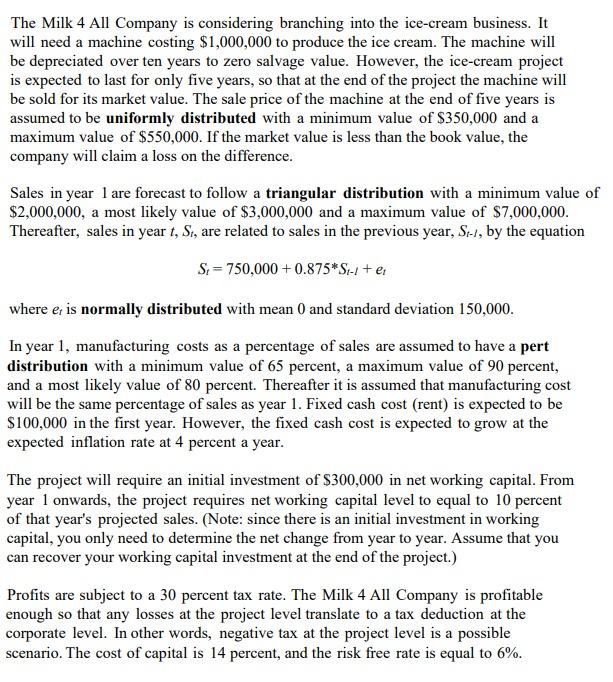

The Milk 4 All Company is considering branching into the ice-cream business. It will need a machine costing $1,000,000 to produce the ice cream. The machine will be depreciated over ten years to zero salvage value. However, the ice-cream project is expected to last for only five years, so that at the end of the project the machine will be sold for its market value. The sale price of the machine at the end of five years is assumed to be uniformly distributed with a minimum value of $350,000 and a maximum value of $550,000. If the market value is less than the book value, the company will claim a loss on the difference. Sales in year 1 are forecast to follow a triangular distribution with a minimum value of $2,000,000, a most likely value of $3,000,000 and a maximum value of $7,000,000. Thereafter, sales in year t, Si, are related to sales in the previous year, S-1, by the equation S = 750,000+0.875*S-1 + e where ez is normally distributed with mean 0 and standard deviation 150,000. In year 1, manufacturing costs as a percentage of sales are assumed to have a pert distribution with a minimum value of 65 percent, a maximum value of 90 percent, and a most likely value of 80 percent. Thereafter it is assumed that manufacturing cost will be the same percentage of sales as year 1. Fixed cash cost (rent) is expected to be $100,000 in the first year. However, the fixed cash cost is expected to grow at the expected inflation rate at 4 percent a year. The project will require an initial investment of $300,000 in net working capital. From year 1 onwards, the project requires net working capital level to equal to 10 percent of that year's projected sales. (Note: since there is an initial investment in working capital, you only need to determine the net change from year to year. Assume that you can recover your working capital investment at the end of the project.) Profits are subject to a 30 percent tax rate. The Milk 4 All Company is profitable enough so that any losses at the project level translate to a tax deduction at the corporate level. In other words, negative tax at the project level is a possible scenario. The cost of capital is 14 percent, and the risk free rate is equal to 6%. 1. How much do sales in year 1 influence the project? Is there any value to conducting additional market research to improve the year 1 sales forecast? 2. The project assumes that the year 1 manufacturing costs will be representative of the costs throughout the project. Is this a reasonable assumption? Given the current forecast distribution, what is the probability that manufacturing costs will be between 75 85% of sales? 3. Calculate the expected NPV of the project over 1000 iterations. What is the 90% confidence interval for the NPV? How many iterations would be required to narrow this confidence in half? 4. What is the value at risk (VAR) for this project? What is the probability of having a negative NPV? 5. Use a tornado diagram to rank the uncertain variables in terms of their influence on the NPV. Comment on the variables with the highest weight. The Milk 4 All Company is considering branching into the ice-cream business. It will need a machine costing $1,000,000 to produce the ice cream. The machine will be depreciated over ten years to zero salvage value. However, the ice-cream project is expected to last for only five years, so that at the end of the project the machine will be sold for its market value. The sale price of the machine at the end of five years is assumed to be uniformly distributed with a minimum value of $350,000 and a maximum value of $550,000. If the market value is less than the book value, the company will claim a loss on the difference. Sales in year 1 are forecast to follow a triangular distribution with a minimum value of $2,000,000, a most likely value of $3,000,000 and a maximum value of $7,000,000. Thereafter, sales in year t, Si, are related to sales in the previous year, S-1, by the equation S = 750,000+0.875*S-1 + e where ez is normally distributed with mean 0 and standard deviation 150,000. In year 1, manufacturing costs as a percentage of sales are assumed to have a pert distribution with a minimum value of 65 percent, a maximum value of 90 percent, and a most likely value of 80 percent. Thereafter it is assumed that manufacturing cost will be the same percentage of sales as year 1. Fixed cash cost (rent) is expected to be $100,000 in the first year. However, the fixed cash cost is expected to grow at the expected inflation rate at 4 percent a year. The project will require an initial investment of $300,000 in net working capital. From year 1 onwards, the project requires net working capital level to equal to 10 percent of that year's projected sales. (Note: since there is an initial investment in working capital, you only need to determine the net change from year to year. Assume that you can recover your working capital investment at the end of the project.) Profits are subject to a 30 percent tax rate. The Milk 4 All Company is profitable enough so that any losses at the project level translate to a tax deduction at the corporate level. In other words, negative tax at the project level is a possible scenario. The cost of capital is 14 percent, and the risk free rate is equal to 6%. 1. How much do sales in year 1 influence the project? Is there any value to conducting additional market research to improve the year 1 sales forecast? 2. The project assumes that the year 1 manufacturing costs will be representative of the costs throughout the project. Is this a reasonable assumption? Given the current forecast distribution, what is the probability that manufacturing costs will be between 75 85% of sales? 3. Calculate the expected NPV of the project over 1000 iterations. What is the 90% confidence interval for the NPV? How many iterations would be required to narrow this confidence in half? 4. What is the value at risk (VAR) for this project? What is the probability of having a negative NPV? 5. Use a tornado diagram to rank the uncertain variables in terms of their influence on the NPV. Comment on the variables with the highest weight








